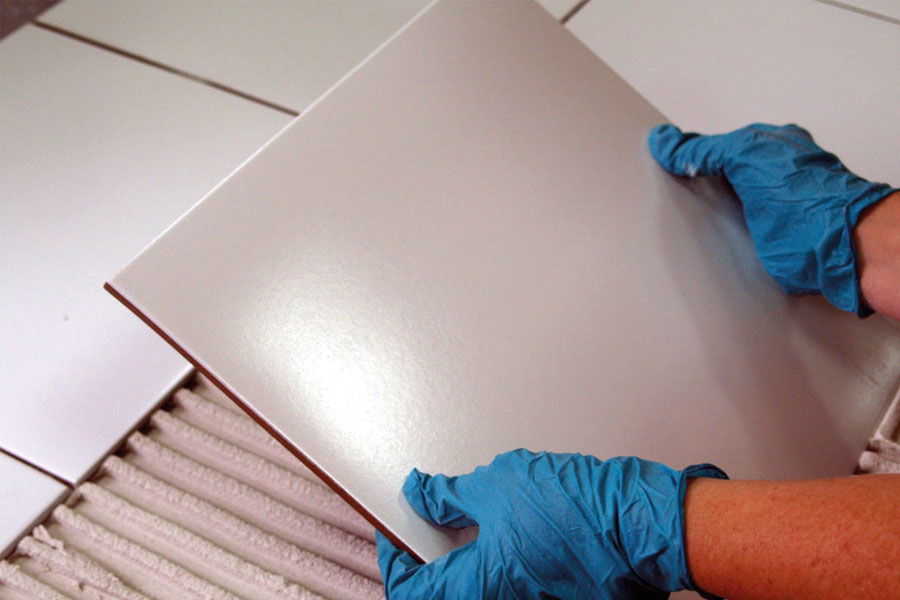Underfloor heating (UFH) can cause an array of issues if not tiled onto correctly, from cracking owing to heat expansion to damaging wires with a trowel. Marc Jackson explains the two solutions for this problem, one for each electric UFH and piped UFH.
COMMON issues and queries you can face when you’re getting to grips with tiling and heat.
1 Movement owing to thermal expansion and contraction
The screed and the adhesive, being of a similar material, expand at a similar rate to each other. However, the tiles usually have a slightly lower coefficient of thermal expansion – so for a given temperature rise they will grow proportionately less. The result on the tile-fixing products is twofold: Stresses build at the interface between the tile and the adhesive.
At some point this will be too great, and the weakest part of the system will yield – usually the bond between the tile and the adhesive. As the base expands in relation to the tiles they try to move slightly further apart stretching the grout joints. Cementitious products are inherently weak in tension and the bond onto the tile edge can fail.
2 Damage to wires from the trowel
One of the most common reasons for problems with the installation of an undertile warming system is damage made during fitting. When covering the wires with adhesive it is quite easy to accidentally cut a wire with the trowel.
3 Switching on too soon weakens the adhesive and grout
Cement-based adhesives and grouts set hydraulically as water is involved in the hardening reaction. If the adhesive is allowed to dry out before it has properly hardened it will tend to be weak and crumbly. It’s important that the heating system is off when tiles are fixed and remains off until the adhesive and grout have fully cured.
SOLUTION 1: Use floor leveller on electric underfloor heating
Our highly polymer-modified levellers, adhesives and grouts have enough flexibility when set to accommodate thermally induced movement.
A floor leveller can be used to cover and protect the wires that otherwise could get damaged during application of the adhesive, and can stabilise movement in the floor.
1 Prepare substrate
First, ensure your substrate is rigid, sound, clean and dry.
For solid substrates: Prime with weber PR360 and allow to dry.
For wooden substrates: Ensure it is capable of supporting the expected load and probable dynamic load, without excessive deflection. You can take up existing boards and stiffen them with noggings to add extra strength. Alternatively, extra rigidity can be achieved through overlaying the existing timber boards with either WBP plywood or tile backer board. Plywood should be at least 18mm thick, primed on the reverse face and edges with weber PR360 and screwed every 300mm. Tongue and groove or floorboards must be screwed to joists using two screws per board at every joist. All boards should be primed with weber PR360. All joints between boards should be filled with weberjoint silicone sealant to prevent leakage during application.
2 Install underfloor heating
Install underfloor heating system in accordance with the manufacturer’s instructions and test that it works. Turn it off and allow to cool. Apply weberfloor flex self-levelling compound up to 50mm deep or until the warming elements are covered by at least 3mm (10mm minimum for wooden substrates). Allow three hours before foot traffic.
3 Lay tiles
Fix the tiles into a bed of weberset pro lite – rapid, weberset rapid SPF or weberset SPF at least 3mm thick (5mm thick for wooden substrates). Leave joints at least 3mm wide for grouting and make provisions for movement. Grout the joints with weberjoint premium or weberjoint wide flex and use weberjoint silicone sealant to fill perimeter movement joints.
4 Allow to cure
Keep the heating/warming system turned off for at least 5 days to allow the cement to cure. Bring the system up to its operating temperature gradually in stages over a few days, don’t exceed 27deg C and no more than 5deg C per day.
SOLUTION 2: Use floor leveller on underfloor heating pipes
Piped heating systems are buried in reinforced cement/sand floating screeds of not less than 65mm thick. If a polymer-modified levelling screed is used it must cover the pipes by a minimum of 10mm. Our highly polymer-modified adhesives and grouts have enough flexibility to accommodate thermally-induced movement.
1 Prepare
The heating pipes should be installed according to manufacturer’s instructions, fixed down and tested prior to being encapsulated in a screed or levelling compound.
If the pipes have been laid in a reinforced cement/sand screed this must be allowed to dry fully prior to tiling. A sand/cement screed should be left for three weeks with the underfloor heating off to dry. After this period, the heating system should be turned on and raised by a maximum of 5deg C/day until the maximum recommended operating temperature is achieved. This temperature should be maintained for three days and then the system turned off and the screed allowed to cool to 15deg C before tiling commences.
If weberfloor flex levelling compound is used to cover the pipes instead of a cement/sand screed, the drying time will be considerably shorter.
Ensure the cured surface of the floor is rigid, sound, clean, dry, and free from any contaminating barrier. Prime with weber PR360 and allow to dry.
2 Lay tiles
Fix the tiles into a solid bed of weberset pro lite – rapid, weberset rapid SPF or weberset SPF at least 3mm thick. Leave joints at least 3mm wide for grouting and make provisions for movement.
Grout the joints with weberjoint premium or weberjoint wide flex and use weberjoint silicone sealant to fill perimeter joints.
3 Allow to cure
Keep the warming system turned off for at least 5 days to allow the cement to cure. Bring the system up to its operating temperature gradually in stages over a few days.


